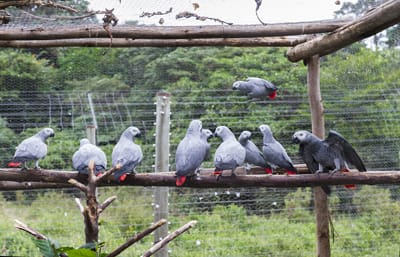Grey Parrots: Confiscation and Rehabilitation
Status:

Collaborators/Funders:
Greenfingers Wildlife Conservation Initiative, Pandrillus Drill Ranch, LWIRO (Centre de Réhabilitation des Primates de Lwiro), ConservCongo, KAFRED (Kibale Association for Rural and Environmental Development), Limbe Wildlife Centre, Focused Conservation and Nigerian Conservation Foundation, the Nigeria National Park Services and Nigeria Customs Service, Dingi Parrot Conservation Centre (Projet de Protection des Perroquets, Lukuru Foundation), National Environmental Standards and Regulations Enforcement Agency (NESREA)
The WPT has supported the seizure, care and management of hundreds of illegally trafficked Grey Parrots (Psittacus erithacus) in the last two decades. In 2020, for the first time, 39 rehabilitated Greys were released back to the wild in the Democratic Republic of the Congo, with a further 63 released after that. Other groups of Grey Parrots have been intercepted in several countries in an uptick of heightened awareness and local collaboration.
In 2022, 120 Grey Parrots were intercepted from a wildlife trafficker in Uganda. They were housed at the Uganda Wildlife Education Centre where they began rehabilitation for eventual release in Kibale National Park. Further, WPT mobilised the care and transport of Grey Parrots confiscated in Eastern Europe to various zoos and sanctuaries. WPT has funded rehabilitation and release aviaries in the Democratic Republic of Congo, Liberia, Senegal, Guinea and Sierra Leone.
Nigeria has become a prominent participant in the global illegal wildlife trade, serving as an important source, destination and transit point. The World Wildlife Seizures database highlights that, over the past decade, the country has been among the top five countries globally in both source and destination categories for seized shipments. In 2022, the government of Nigeria published a new National Strategy to Combat Wildlife and Forest Crime, opening the door to much-needed actions.
Grey Parrots were seized by Nigerian Customs in 2022 and 2023 during multiple operations involving over 130 parrots. WPT coordinated the transfer of the parrots to Pandrillus Drill Ranch in Cross River Province, supported the construction of a quarantine aviary in Calabar and a specialised flight aviary at Drill Ranch in Afi Mountain Sanctuary, where the parrots recovered. Prior to their release, WPT veterinarian Dr. Steven Janssen health-checked the parrots and provided training on caring for trafficked birds. The release event was covered on national television, helping to raise awareness about the illegal wildlife trade and was attended by principal representatives of Nigeria’s Minister of the Environment and National Park Service. The release also received the approval of local leaders.
The WPT teamed up with the P3M project in 2023 to establish the Dingi Parrot Rescue Centre near Kindu in central Democratic Republic of Congo, a key hotspot in the trade in Grey Parrots. The facility has received over 200 parrots, many of which have been returned to the wild. Crucially, the centre has hosted meetings with Provincial authorities that prompted the announcement of a decree, which has now been replicated in two neighbouring provinces, banning the capture and trade of Grey Parrots.
IUCN/CITES Status: Endangered / Appendix I
Population: As few as 560,000, decreasing.
Threats: Grey Parrots are now threatened throughout much of their natural range: extensive deforestation, particularly in W Africa, and heavy trapping for the wild bird trade have caused population collapses in some countries.
Range: Grey Parrots are found in S Nigeria, S Central African Republic, Republic of Congo, DRC, Gabon, Equatorial Guinea, SE Ivory Coast, N Angola, S Democratic Republic of Congo, NW Tanzania, W Kenya, W Uganda, Principe and Bioko Islands.
Natural history: Seen in primary and secondary rainforest, clearings, mangroves, wooded savanna, cultivated land and gardens to an altitude of 2200 m (7216 ft). Diet includes fruits and seeds, particularly oil palm fruit. Flocks roost in palms over water or on islands in rivers. Breeding is January-February and June-July, E Africa; in other areas the dry season. Nest is a cavity in a tall living tree.
Trafficked parrots return to DRC – December 12, 2024
New Harvard and NYU report highlights zoonotic risks in wildlife trade – September 2, 2024
Innovative legal training launched to combat Grey Parrot trafficking in DRC – May 27, 2024
Congo journey: Working together to give African Greys a second chance in the DRC – October 21, 2021
Wild-trapped parrots fly free again over eastern Congo’s forests – 2020
Confiscated Grey Parrots thriving in the wild three years on – August 8, 2016
